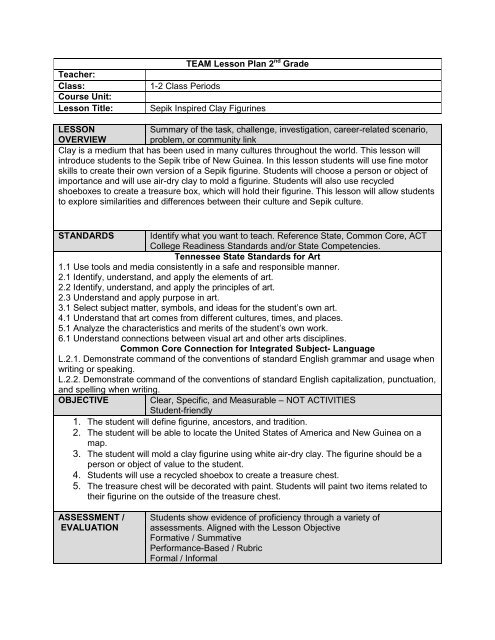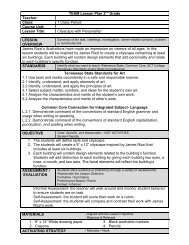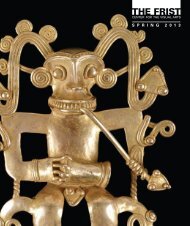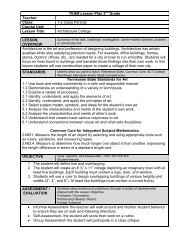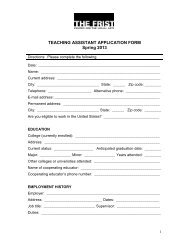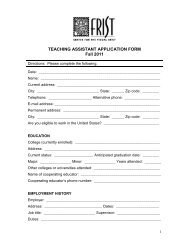a lesson plan to use in your classroom - Frist Center for the Visual Arts
a lesson plan to use in your classroom - Frist Center for the Visual Arts
a lesson plan to use in your classroom - Frist Center for the Visual Arts
- No tags were found...
You also want an ePaper? Increase the reach of your titles
YUMPU automatically turns print PDFs into web optimized ePapers that Google loves.
Teacher:Class:Course Unit:Lesson Title:TEAM Lesson Plan 2 nd Grade1-2 Class PeriodsSepik Inspired Clay Figur<strong>in</strong>esLESSONSummary of <strong>the</strong> task, challenge, <strong>in</strong>vestigation, career-related scenario,OVERVIEW problem, or community l<strong>in</strong>kClay is a medium that has been <strong>use</strong>d <strong>in</strong> many cultures throughout <strong>the</strong> world. This <strong>lesson</strong> will<strong>in</strong>troduce students <strong>to</strong> <strong>the</strong> Sepik tribe of New Gu<strong>in</strong>ea. In this <strong>lesson</strong> students will <strong>use</strong> f<strong>in</strong>e mo<strong>to</strong>rskills <strong>to</strong> create <strong>the</strong>ir own version of a Sepik figur<strong>in</strong>e. Students will choose a person or object ofimportance and will <strong>use</strong> air-dry clay <strong>to</strong> mold a figur<strong>in</strong>e. Students will also <strong>use</strong> recycledshoeboxes <strong>to</strong> create a treasure box, which will hold <strong>the</strong>ir figur<strong>in</strong>e. This <strong>lesson</strong> will allow students<strong>to</strong> explore similarities and differences between <strong>the</strong>ir culture and Sepik culture.STANDARDS Identify what you want <strong>to</strong> teach. Reference State, Common Core, ACTCollege Read<strong>in</strong>ess Standards and/or State Competencies.Tennessee State Standards <strong>for</strong> Art1.1 Use <strong>to</strong>ols and media consistently <strong>in</strong> a safe and responsible manner.2.1 Identify, understand, and apply <strong>the</strong> elements of art.2.2 Identify, understand, and apply <strong>the</strong> pr<strong>in</strong>ciples of art.2.3 Understand and apply purpose <strong>in</strong> art.3.1 Select subject matter, symbols, and ideas <strong>for</strong> <strong>the</strong> student’s own art.4.1 Understand that art comes from different cultures, times, and places.5.1 Analyze <strong>the</strong> characteristics and merits of <strong>the</strong> student’s own work.6.1 Understand connections between visual art and o<strong>the</strong>r arts discipl<strong>in</strong>es.Common Core Connection <strong>for</strong> Integrated Subject- LanguageL.2.1. Demonstrate command of <strong>the</strong> conventions of standard English grammar and usage whenwrit<strong>in</strong>g or speak<strong>in</strong>g.L.2.2. Demonstrate command of <strong>the</strong> conventions of standard English capitalization, punctuation,and spell<strong>in</strong>g when writ<strong>in</strong>g.OBJECTIVE Clear, Specific, and Measurable – NOT ACTIVITIESStudent-friendly1. The student will def<strong>in</strong>e figur<strong>in</strong>e, ances<strong>to</strong>rs, and tradition.2. The student will be able <strong>to</strong> locate <strong>the</strong> United States of America and New Gu<strong>in</strong>ea on amap.3. The student will mold a clay figur<strong>in</strong>e us<strong>in</strong>g white air-dry clay. The figur<strong>in</strong>e should be aperson or object of value <strong>to</strong> <strong>the</strong> student.4. Students will <strong>use</strong> a recycled shoebox <strong>to</strong> create a treasure chest.5. The treasure chest will be decorated with pa<strong>in</strong>t. Students will pa<strong>in</strong>t two items related <strong>to</strong><strong>the</strong>ir figur<strong>in</strong>e on <strong>the</strong> outside of <strong>the</strong> treasure chest.ASSESSMENT /EVALUATIONStudents show evidence of proficiency through a variety ofassessments. Aligned with <strong>the</strong> Lesson ObjectiveFormative / SummativePer<strong>for</strong>mance-Based / RubricFormal / In<strong>for</strong>mal
In<strong>for</strong>mal Assessment- <strong>the</strong> teacher will walk around <strong>to</strong> moni<strong>to</strong>r student behavior <strong>to</strong> ensure<strong>the</strong> students are on task.Self-Assessment- <strong>the</strong> student will score <strong>the</strong>ir work on a rubric.Self-Assessment- <strong>the</strong> students will reflect <strong>in</strong> <strong>the</strong>ir journal on <strong>the</strong> similarities anddifferences between <strong>the</strong>ir figur<strong>in</strong>e and traditional Sepik figur<strong>in</strong>es.Group-Assessment- students will participate <strong>in</strong> a class critique.MATERIALSAligned with <strong>the</strong> Lesson ObjectiveRigorous & Relevant1. White air-dry clay6. Various clay <strong>to</strong>ols2. Recycled shoe boxes7. Cups of water3. Tempera pa<strong>in</strong>t8. Paper <strong>to</strong>wels4. Pa<strong>in</strong>t brushes9. Pa<strong>in</strong>t palettes5. Ziploc sandwich bags10. PencilsACTIVATING STRATEGYMotiva<strong>to</strong>r / HookAn Essential Question encourages students <strong>to</strong> put<strong>for</strong>th more ef<strong>for</strong>t when faced with complex, openended,challeng<strong>in</strong>g, mean<strong>in</strong>gful, and au<strong>the</strong>nticquestions.1. As students enter <strong>the</strong> <strong>classroom</strong> <strong>the</strong> teacher will be play<strong>in</strong>g traditional Sepik music.2. The teacher will <strong>in</strong>struct students <strong>to</strong> close <strong>the</strong>ir eyes while listen<strong>in</strong>g <strong>to</strong> <strong>the</strong> music.3. The teacher will ask students <strong>to</strong> imag<strong>in</strong>e where <strong>the</strong>y might hear this type of music.INSTRUCTIONStep-By-Step Procedures – SequenceDiscover / Expla<strong>in</strong> – Direct InstructionModel<strong>in</strong>g Expectations – “I Do”Question<strong>in</strong>g / Encourages Higher Order Th<strong>in</strong>k<strong>in</strong>gGroup<strong>in</strong>g StrategiesDifferentiated Instructional Strategies <strong>to</strong> ProvideIntervention & Extension
1. See set.2. The teacher will <strong>in</strong>troduce <strong>the</strong> project with a pre-made example and state objectives.3. The teacher will show where New Gu<strong>in</strong>ea is located on a map and will expla<strong>in</strong> that <strong>the</strong>Sepik tribe is located <strong>in</strong> New Gu<strong>in</strong>ea.4. The teacher will show pictures from New Gu<strong>in</strong>ea culture and Sepik art.5. Students will write about a person or object that is important <strong>to</strong> <strong>the</strong>m.6. The teacher will demonstrate proper <strong>use</strong> of clay <strong>to</strong>ols while allow<strong>in</strong>g students <strong>to</strong> passaround and feel a ball of air-dry clay.7. The teacher will demonstrate how <strong>to</strong> <strong>for</strong>m <strong>the</strong> air-dry clay <strong>in</strong><strong>to</strong> a figur<strong>in</strong>e.8. Students will receive a ball of white air-dry clay and a Ziploc bag.9. The students will practice manipulat<strong>in</strong>g <strong>the</strong> clay with <strong>the</strong>ir hands.10. After 5 m<strong>in</strong>utes of practice, <strong>the</strong> teacher will <strong>in</strong>struct <strong>the</strong> students <strong>to</strong> beg<strong>in</strong> work<strong>in</strong>g on<strong>for</strong>m<strong>in</strong>g <strong>the</strong> figur<strong>in</strong>e.11. The teacher will walk around and moni<strong>to</strong>r student behavior and keep students on task.12. The students will write <strong>the</strong>ir names on <strong>the</strong> back of <strong>the</strong> paper that listed <strong>the</strong>ir person/itemof importance. Students will place <strong>the</strong>ir paper <strong>in</strong>side <strong>the</strong> Ziploc bag and place <strong>the</strong> figur<strong>in</strong>eon <strong>to</strong>p. NOTE: If students are not f<strong>in</strong>ished sculpt<strong>in</strong>g <strong>the</strong>ir figur<strong>in</strong>e, <strong>the</strong> clay should beplaced <strong>in</strong> <strong>the</strong> Ziploc bag and sealed <strong>to</strong> f<strong>in</strong>ish next class. If <strong>the</strong> student is done, <strong>the</strong>figur<strong>in</strong>e must be left out <strong>to</strong> air dry.13. The students will place <strong>the</strong>ir figur<strong>in</strong>es and Ziploc bags on <strong>the</strong> designated counter.14. At <strong>the</strong> start of <strong>the</strong> next class <strong>the</strong> teacher will review clay safety and <strong>in</strong><strong>for</strong>m students thatclay figur<strong>in</strong>es are due at <strong>the</strong> end of class.15. The teacher will expla<strong>in</strong> that once figur<strong>in</strong>es are complete students may design ashoebox <strong>to</strong> hold <strong>the</strong> figur<strong>in</strong>e. Students will pa<strong>in</strong>t two items on <strong>the</strong> shoebox that areimportant <strong>to</strong> <strong>the</strong> figur<strong>in</strong>e.16. The teacher will lead a demonstration on pa<strong>in</strong>t<strong>in</strong>g <strong>the</strong> shoebox and will show an exampleof a completed treasure box.17. The students will beg<strong>in</strong> pa<strong>in</strong>t<strong>in</strong>g <strong>the</strong>ir shoeboxes by shar<strong>in</strong>g a palette of pa<strong>in</strong>t with <strong>the</strong>irneighbor.18. Cleanup will occur dur<strong>in</strong>g <strong>the</strong> last ten m<strong>in</strong>utes of class. Students will return materials andwill place <strong>the</strong>ir projects <strong>in</strong> <strong>the</strong> appropriate class b<strong>in</strong>.ALTERNATE/EXTRA ACTIVITIESStudents may <strong>use</strong> construction paper <strong>to</strong> wrap <strong>the</strong> shoebox.If students <strong>use</strong> construction paper on <strong>the</strong> shoeboxes <strong>the</strong>y can <strong>use</strong> washable markers <strong>to</strong>add decoration.CLOSUREReflection / Wrap-UpSummariz<strong>in</strong>g, Rem<strong>in</strong>d<strong>in</strong>g, Reflect<strong>in</strong>g, Restat<strong>in</strong>g, Connect<strong>in</strong>g1. Students will participate <strong>in</strong> a class critique.2. The students will def<strong>in</strong>e figur<strong>in</strong>e, ances<strong>to</strong>r, and tradition.3. The students will locate New Gu<strong>in</strong>ea on a map.CROSS-CURRICULAR CONNECTIONS1. Geography2. Music3. Writ<strong>in</strong>g
Extended Learn<strong>in</strong>gBooks: World Geography and Cultures by Richard G. Boehm. Art Around <strong>the</strong> World: Loo-Loo, Boo, and More Art You Can Do by Denis Roche.Onl<strong>in</strong>e Enrichment: <strong>Arts</strong>connected Sepik Art:http://www.artsconnected.org/resource/list#query=sepik&f_InstitutionTitle=All%20Institutions&d_InstructionalMethod=All&d_Grade=All&w_HasThumbnailMedia=on&w_DisplayResourceType=All&w_Culture=All&w_DisplayCrea<strong>to</strong>r=&f_avDisplayCrea<strong>to</strong>r=&combosort=relevance_desc&sortby=relevance&order=desc&perpage=20&page=1&category=work&spell<strong>in</strong>g=true National Geographic Papua New Gu<strong>in</strong>ea:http://travel.nationalgeographic.com/travel/countries/papua-new-gu<strong>in</strong>ea-guide/Additional Activity: Art Projects from Around <strong>the</strong> World:http://www.barnesandnoble.com/w/art-projects-from-around-<strong>the</strong>-world-l<strong>in</strong>daevans/1102325004?ean=9780439385312For additional <strong>lesson</strong> <strong>plan</strong>s and activities, visit us onl<strong>in</strong>e at www.fristkids.org.This <strong>lesson</strong> <strong>plan</strong> was created by an art education student <strong>in</strong> <strong>the</strong> <strong>Frist</strong> <strong>Center</strong> <strong>for</strong> <strong>the</strong> <strong>Visual</strong> <strong>Arts</strong>’ Teach<strong>in</strong>g Assistantprogram under <strong>the</strong> guidance of education department staff and/or a men<strong>to</strong>r teacher.The Teach<strong>in</strong>g Assistant program is designed <strong>to</strong> <strong>in</strong>troduce participants <strong>to</strong> m<strong>use</strong>um education by provid<strong>in</strong>g uniqueteach<strong>in</strong>g experiences <strong>in</strong> an <strong>in</strong><strong>for</strong>mal learn<strong>in</strong>g environment. For more <strong>in</strong><strong>for</strong>mation about this program or o<strong>the</strong>reducational opportunities offered by <strong>the</strong> <strong>Frist</strong> <strong>Center</strong>, please visit our website at www.fristcenter.org.


